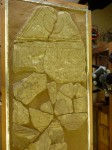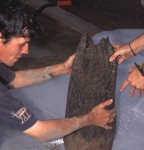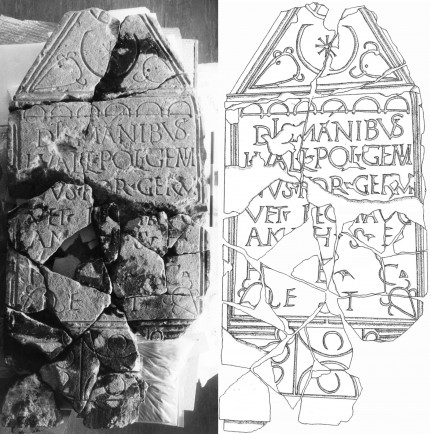 The tombstone of Lucius Valerius Geminus, veteran of the Legio II Augusta, one of the elite legions that first invaded Britain in 43 A.D. under the Emperor Claudius, the legion which defeated Boudica and built Hadrian’s wall, is going on public display at the Oxfordshire Museum in Woodstock for the first time since its discovery in 2003.
The tombstone of Lucius Valerius Geminus, veteran of the Legio II Augusta, one of the elite legions that first invaded Britain in 43 A.D. under the Emperor Claudius, the legion which defeated Boudica and built Hadrian’s wall, is going on public display at the Oxfordshire Museum in Woodstock for the first time since its discovery in 2003.
The tombstone was found in the foundations of the town wall near the west gate of Alchester, a Roman town two miles south of the modern Oxfordshire town of Bicester. The stone had been broken into 20 pieces and reused for rubble in the foundations of the stone wall which we know from coin evidence was built after 260 A.D. and before the abandonment of the town in the 5th century. The town was preceded by a Roman military base the construction of which, thanks to dendrochronological analysis of two wooden gateposts found at the front gate preserved by waterlogged ground, we can date incredibly precisely to between October of 44 A.D. and March of 45 A.D.
What makes this tombstone such a significant find is the biographical detail in the inscription describing a soldier who most likely participated in the initial conquest of Britain and then settled in the province after his retirement. It’s the only personal biography we have of anyone living in Oxfordshire before the Middle Ages, and the first for an individual veteran in the entire province of Britannia.
Here is the text of the inscription:
Dis. Manibus/ L(ucius) Val(erius) L(uci filius) Pol(lia tribu) Gemi/nus For(o) Germ(anorum)/ vet(eranus) Leg(ionis) [I]I Aug(ustae)/ an(norum) L. h(ic) s(itus) e(st)/ he(res) c(uravit)/ e(x) t(estamento)
“To the souls of the departed: Lucius Valerius Geminus, the son of Lucius, of the Pollia voting tribe, from Forum Germanorum, veteran of the Second Augustan Legion, aged 50(?), lies here. His heir had this set up in accordance with his will.”
 Forum Germanorum was a one-horse town in north-west Italy at the base of the Alps in what is today the Piemonte region. It was once part of the province of Gallia Cisalpina (Gaul on this side of the Alps) but had been granted Latin Rights in 89 B.C. under a law promoted by (and maybe even written by) Gnaeus Pompeius Strabo, father of the triumvir Gnaeus Pompeius Magnus. Lucius Valerius’s epitaph was inscribed 70 or so years later and his membership in the Pollia voting tribe still ranked a mention.
Forum Germanorum was a one-horse town in north-west Italy at the base of the Alps in what is today the Piemonte region. It was once part of the province of Gallia Cisalpina (Gaul on this side of the Alps) but had been granted Latin Rights in 89 B.C. under a law promoted by (and maybe even written by) Gnaeus Pompeius Strabo, father of the triumvir Gnaeus Pompeius Magnus. Lucius Valerius’s epitaph was inscribed 70 or so years later and his membership in the Pollia voting tribe still ranked a mention.
Since we know that he had to have died before the garrison left Alchester around 60 A.D., his approximate age at death (50), the general age of army recruits (17-25) and the standard term of service for a legionary (25-30 years), we can deduce he joined the legions during the reign of Tiberius (14-37 A.D.). The base of the Second Augustan Legion at that time was Strasbourg from which he may have participated in Caligula’s quasi campaign (he just executed a bunch of his own people and moved around, really) in Germany from 39-40 A.D. Less than two years later, the future emperor Vespasian became commander of Legio II Augusta and it was he who brought it from Strasbourg to Britain in 43 A.D.
It’s unlikely that Lucius Valerius died away from home and was buried on the spot. As noted in the inscription, the gravestone was inscribed and installed according to the explicit instructions in his will. Obviously he felt no need to be interred back home in Forum Germanorum — he’d probably been gone decades by then — because it wasn’t at all unheard of for soldiers on expedition to be returned home for burial even over great distances but he chose to rest eternally in British soil.
No accompanying burial was found during the 2003 excavation of the Alchester walls. This makes sense because he would have been buried outside of the city, probably along a road. What seems most likely to have happened is a couple of hundred years after his death and burial, Lucius’ gravestone was broken up and moved by cart to the construction site of the new town walls. It was probably a deliberate breakage and transport rather than someone collecting random broken stones because so much of it was found in the rubble foundation.
After its discovery, the tombstone was studied and painstakingly piece back together by experts at the Oxfordshire Museum. Starting July 20th, the gravestone of Lucius Valerius Geminus, first known legionary of Britannia, will be on display in the museum’s History in the Making Exhibition.

Wow. WOW. The idea of having the tombstone of a man who saw the invasion of Britain, and Boudicca’s attack, and Hadrian’s Wall built–that just blows me away.
Thank you for posting this blog about the tombstone of Lucius Valerius Geminus. We recently returned with our teenage boys from our family vacation to the UK and had an opportunity to see this in person at the museum. My older son in particular is a history buff (even managed to get a history scholarship to Duke) and pointed the significance of this tombstone to us while we were there or else we could have easily walked pass by it. The other notable viewing is the Roman Gallery where it exhibits some 18th Century Stonesfield/Roman Oxfordshire embroideries.
I recently learned that the ‘Celts’ already had some sort of early infrastructure. Prior to its ‘Latinization’, however, Forum Germanorum seems to have existed in the cisalpine aerea in between the Etruscans and the Celtic South. Some maps: (a) latin Piemont, (b) Celts, (c) the Alps around 14AD.
:hattip:
History In The Making
Broadcast as a double episode on the Community Channel
Sunday 8th June 2014 @7.30pm Sky 539 | Virgin Media 233 |Freesat 651| Freeview 63
Episode 1 Alchester Project Army Cadets working with memorial sculptor to design a war memorial, celebrating the traditions of Stonemasonry and the techniques originally used, inspired by Roman tombstone, which was excavated in 2003 at Alchester of Lucius Valerius Geminus.
Episode 2 Unearthing The Anglo Saxons Blacksmiths are commissioned to make a replica of a Saxon Sword which was buried with its owner and lay underground for 1500 years until it was discovered by archaeologists excavating to make way for the Shrivenham by-pass, near Watchfield in the 1980s.
Whether we belive this or not ….. This is an interesting coincidence that coincides with this extraordinary find. I have friend who is an archeologist but also claims the power of ESP. An ability to look into the past and to recieve messages from the past.
A year ago he had contacted me with a message he had received from a Gallic Druid of Aedui Tribe that there was a ring placed within an burial urn from a Calvary auxilia killed at the battle of Alesia July 58BC. This ring was awaiting for it to be rediscovered again and given to myself for some yet unexplained reason.
This ring was givin exact coordinates by the Druid which was found by my friend within a broken urn and the burnt remains of the Auxilia Calvary Legionare . Once ring was retrieved the name of the Auxilia was revealed : Lucius Vilerius Gemilius !!!!!!!
I know there is small difference in spelling but the coincidence is extraordinary !!! This Lucius was 38 when killed in battle fighting for Caeser and was from the Aedui Tribe. My theory is that this Lucius is the Granfather of this Lucius Valerius Gemilus whose father is also Lucius .
What do others think ????
THank you for helping us to pee into history and have a look at the best tombstones of the past …Well written !!!
Thanks for the wonderful information you shared with us.
This is a really quality post.I find this information through Google. Great job
Wonderful blog and very useful information ..i enjoy it.
Great content thanks for sharing